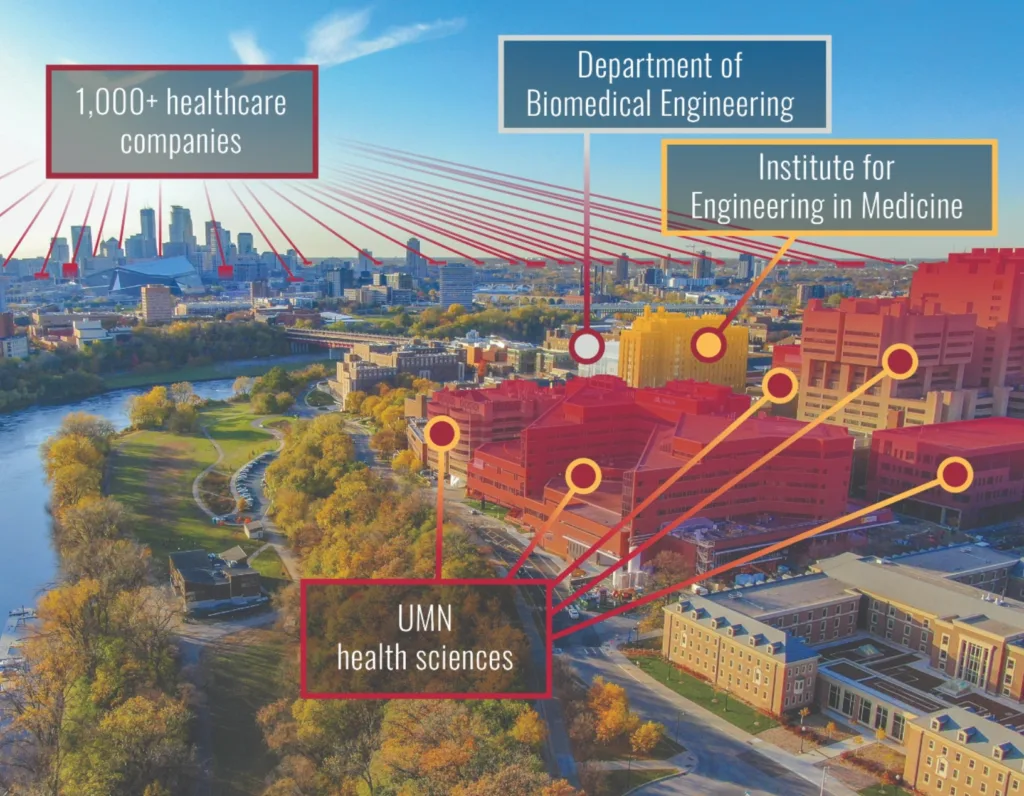Chair, Department of Neurosurgery
University of Minnesota Medical School
Minneapolis, Minnesota
Position Description
The University of Minnesota Medical School invites applications for the role of Chair of the Department of Neurosurgery. This prestigious position presents a unique opportunity for an accomplished leader to shape the future of neurosurgery within one of the nation’s top academic health systems. The successful candidate will advance the department’s mission of excellence in patient care, research, and education while fostering innovation and upholding its legacy of clinical and academic achievement.
Role & Responsibilities
The successful candidate will possess a strong vision for the future of neurosurgery and the ability to translate that vision into a thriving department. As Chair, you will play a pivotal role in:
- Strategic Leadership: Develop and execute a visionary strategic plan that enhances the department’s clinical, research, and educational programs while aligning with the broader goals of the University of Minnesota Medical School and health system partners.
- Faculty Development: Recruit, mentor, and retain exceptional faculty and staff, fostering a culture of collaboration, inclusion, and professional growth.
- Research Advancement: Oversee a robust and diverse research portfolio, promoting interdisciplinary collaboration and securing extramural funding to advance neurosurgical science.
- Clinical Excellence: Guide the strategic growth of clinical programs, ensuring the delivery of cutting-edge, patient-centered care across all subspecialties.
- Education and Training: Champion the department’s educational mission by enhancing residency and fellowship programs, supporting innovative teaching methods, and preparing the next generation of neurosurgical leaders.
- Financial and Operational Management: Manage departmental resources effectively, including budget oversight, philanthropic development, and resource allocation to support strategic priorities.
- External Engagement: Cultivate relationships with regional and national healthcare leaders, industry partners, and community stakeholders to expand the department’s influence and impact.
Required Qualifications
- Educational and Professional Credentials:
- MD or DO degree with board certification in Neurological Surgery.
- Eligible for medical licensure in the state of Minnesota.
- Qualified for appointment at the rank of Professor in the University of Minnesota Medical School.
- Leadership Experience:
- At least 10 years of progressive leadership experience in an academic medical setting, with a proven record of success in advancing departmental goals and initiatives.
- Demonstrated ability to lead multidisciplinary teams and inspire excellence across education, research, and clinical care.
- Academic Excellence:
- Nationally and/or internationally recognized expertise in neurological surgery, as evidenced by a distinguished record of scholarly contributions, including high-impact peer-reviewed publications.
- Successful track record in securing competitive research funding (e.g., NIH, foundations, industry).
- Skills and Competencies:
- Exceptional leadership, interpersonal, and communication skills, with the ability to engage effectively with diverse audiences, including faculty, staff, students, patients, donors, and external stakeholders.
- Proven ability to foster and sustain collaborative relationships across departments, institutions, and external partners.
- Strong fiscal management skills, with experience overseeing complex budgets and allocating resources efficiently to support strategic priorities.
- Mentorship and Faculty Development:
- Demonstrated commitment to mentoring and developing junior faculty and trainees, fostering career growth and academic achievement.
- Clinical Excellence and Innovation:
- Proven ability to develop and expand clinical programs, ensuring patient safety, quality of care, and improved access to services.
- Commitment to Diversity, Equity, and Inclusion:
- A strong dedication to advancing diversity, equity, and inclusion in all aspects of the department’s mission, including faculty recruitment, mentorship, and patient care initiatives.
Why Join Us?
The University of Minnesota Medical School is a world-class institution renowned for its commitment to advancing medical discovery, education, and patient care. The Department of Neurosurgery, with its rich history of innovation and collaboration, is poised for transformative growth under the leadership of a dynamic and visionary Chair. This role offers an unparalleled platform to influence the future of neurosurgery and contribute to the University’s broader mission of improving health through discovery and innovation.
Join us in shaping the next chapter of neurosurgical excellence in one of the nation’s most vibrant and livable metropolitan areas—the Twin Cities of Minneapolis and St. Paul.
Department of Neurosurgery
The Department of Neurosurgery at the University of Minnesota Medical School provides cutting-edge patient care, world-class education, and transformative research. Our commitment to innovation and excellence makes us a leader in addressing the most complex neurosurgical challenges.
Key Features:
- 8 Research Labs: Advancing discovery in key areas such as neuro-oncology, stem cell therapies, and spinal cord injury recovery.
- 13 Residents & 3 Fellowship Programs: Providing comprehensive training and mentorship in all facets of neurosurgery.
- 21 Faculty Members: Including pioneers in neurosurgical techniques and clinical research.
Renowned Achievements:
- Introducing dexamethasone for treating cerebral edema.
- Pioneering stem cell therapies for neurological disorders.
- Innovating techniques such as deep brain stimulation (DBS) for Parkinson’s disease and epidural spinal stimulation for spinal cord injuries.
- Advancing intraoperative imaging with the state’s first intraoperative MRI suite.
Education Programs:
The Department is dedicated to preparing future leaders in neurosurgery through a robust education program that emphasizes clinical excellence and research innovation.
- Residency Program
- With over 75 years of history, our residency program offers training across all neurosurgical specialties, including neuro-oncology, pediatric neurosurgery, and trauma care. Graduates consistently go on to leadership roles, reflecting the program’s emphasis on individualized mentorship and skill development.
- Fellowship Programs:
- Stereotactic and Functional Neurosurgery: Advanced training in movement disorders, epilepsy, and spinal cord injury treatments.
- Neuroanatomy Fellowship: Focused research in brain anatomy, imaging, and neurosurgical techniques.
- Endovascular Surgical Neuroradiology Fellowship: Comprehensive training in cerebrovascular disease with exposure to cutting-edge interventions.
Research
Our department conducts groundbreaking research to transform the understanding and treatment of neurosurgical conditions. Key focus areas include:
- Neuromodulation: The Department is at the forefront of research in deep brain stimulation (DBS) and neuromodulation therapies. Collaborating closely with the Neuromodulation Research Center (NMRC), the department integrates expertise from neurology, neurosurgery, neuroscience, biomedical engineering, and radiology to advance treatments for brain conditions. Notably, the department has pioneered the use of DBS for movement disorders, becoming the first in the nation to implant a newly approved DBS device for Parkinson’s disease and essential tremor. This commitment to innovation underscores the department’s leading role in neuromodulation research and its dedication to improving patient outcomes.
- Stem cell use in the treatment of neurological disorders such as ischemic brain injury, Parkinson’s disease and spinal cord injury
- Gene therapies, including development of vector systems for treating lysosomal storage disorders of the brain such as MPS I (Hurler Syndrome) and MSP II (Hunter’s Syndrome)
- Neuro-oncology projects, including a collaboration with the Department of Pediatrics and College of Veterinary Medicine to create vaccines to fight brain tumors in humans and their canine companions as well as multicenter trials for treatments of brain tumors using blood-brain barrier disruption
- Projects on neuro-protective compounds include the study of anti-apoptotic agents such as tauro-ursodeoxycholic acid (TUDCA) to prevent neuronal loss in conditions such as stroke, Alzheimer’s disease and spinal cord injury
- Projects on neuro-transport include the study of water movement for hydrocephalus and debris/blood from trauma out of the intracranial cavity.
These efforts are supported by extensive collaboration with the NIH, VA, state of Minnesota, Hennepin County Medical Center, and private industry.
Research Labs
The Department’s Research Labs include:
- Brain Injury Research Lab
- Brain Tumor Program
- Stroke, Brain Injury & Stem Cell Lab
- Herman Darrow Lab
- Neuroanatomy Lab
- Parr Lab
- Venteicher Lab
- Walter Low Lab
Patient Care
Our neurosurgeons provide comprehensive care for conditions of the brain, spine, and nervous system. We leverage state-of-the-art technologies, including:
- Intraoperative MRI: Enabling real-time surgical guidance and enhanced outcomes.
- Gamma Knife Radiosurgery: Precise, non-invasive treatments for complex cases.
- ROSA Robotics System: Revolutionizing procedures like electrode implantation for epilepsy.
- Mazor X Stealth Edition Robotics Guidance Platform, a robotic surgical system that increases surgical accuracy. The platform allows spinal surgeons to create detailed digital plans before each surgery, and then uses real-time 3D imagery paired with a robotic guided arm to help surgeons place spinal implants during delicate operations.
Conditions treated include brain tumors, cerebrovascular and spinal diseases, hydrocephalus, and Parkinson’s disease, among others. Our collaboration with Fairview Health Services allows the neurosurgical department to provide services across a health system that serves both the Twin Cities and surrounding areas. The health system has a centralized transfer center, University of Minnesota supported telestroke network and the potential to grow both cranial and spinal surgeries in multiple locations.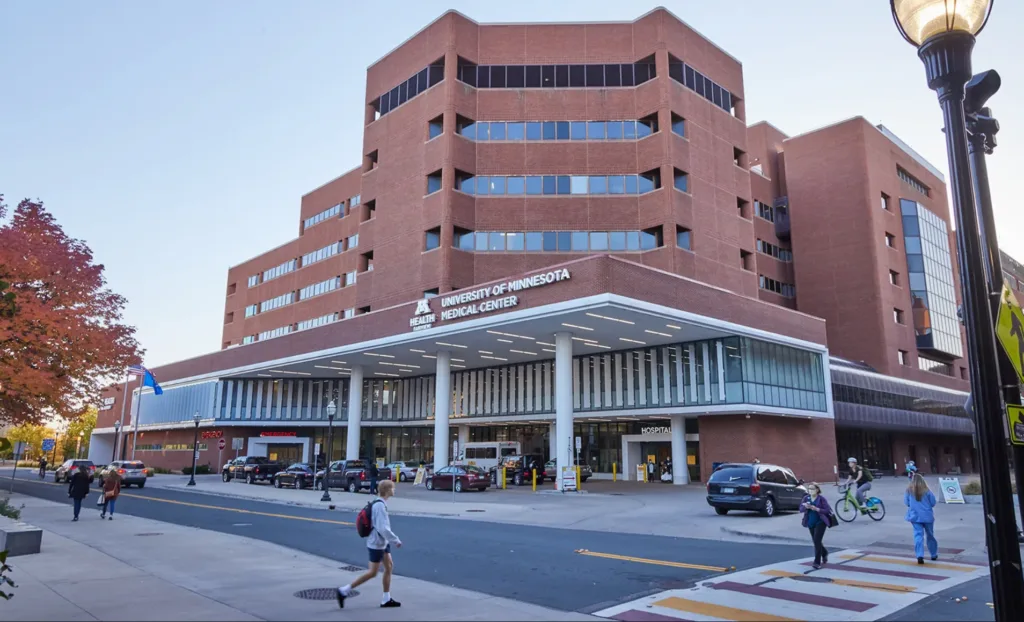
Key Clinical Sites & Health Partners
M Health Fairview University of Minnesota Medical Center
M Health Fairview University of Minnesota Medical Center (UMMC) is a 1,700-bed non-profit, tertiary, research, and academic medical center located in Minneapolis, Minnesota. It is the region’s only university-level academic medical center and the largest hospital within the M Health Fairview Health System. UMMC is affiliated with the University of Minnesota Medical School and serves as a hub for groundbreaking research, education, and patient care. Designated as an ACS Level III Trauma Center, UMMC provides advanced care across a range of specialties, including neurosurgery, oncology, cardiology, and transplant services.
The medical center spans two campuses: the East Bank campus and the West Bank campus, which was previously Saint Mary’s Hospital and Fairview-Riverside Medical Center. Attached to UMMC is the Masonic Children’s Hospital, a leading facility for pediatric care that treats patients from infancy through adolescence and young adulthood. UMMC’s integration of research, teaching, and clinical care makes it a cornerstone for innovation and collaboration in healthcare.
M Health Fairview Southdale Hospital
Fairview Southdale Hospital provides care to individuals living and working in the southwest Twin Cities metro area. Its doctors and staff collaborate closely with patients to deliver personalized care using the latest technology. The hospital offers convenient access to over 40 specialty services, including cardiology, orthopedics, oncology, obstetrics, primary care, neurosciences, critical care, vascular, and emergency services. Physician partners from Fairview, Fairview Physician Associates, University of Minnesota Physicians, and independent providers throughout the southwest metro and beyond combine their expertise to integrate innovative technologies and treatments with the art of medicine.
UMN Clinics and Surgery Center (CSC)
The UMN Clinics and Surgery Center (CSC) is a state-of-the-art outpatient facility that serves as the primary site for neurosurgical consultations and minimally invasive procedures. Designed to enhance patient experience and streamline care delivery, the CSC features cutting-edge imaging, surgical suites, and multidisciplinary care teams. Neurosurgery services at CSC include pre- and post-operative care for brain and spinal procedures, management of chronic pain conditions, and advanced treatment planning for complex neurosurgical cases. This innovative center bridges clinical care and research, offering opportunities to lead advancements in neurosurgical techniques and patient outcomes.
Hennepin County Medical Center
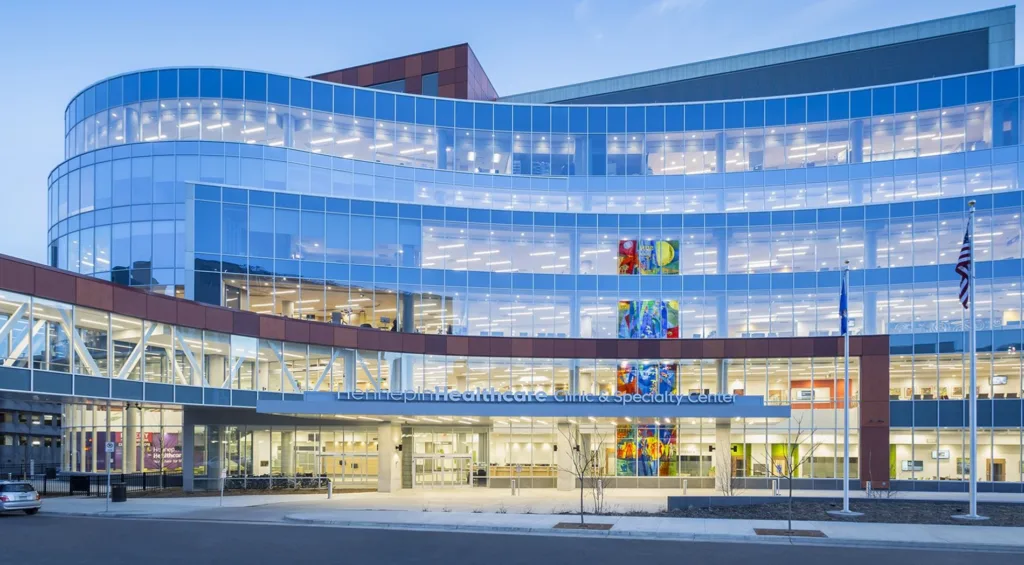
Hennepin Healthcare is a premier safety-net healthcare system in Minnesota, anchored by its 484-bed Level 1 Adult and Pediatric Trauma Center. With a high volume of trauma and emergency cases, Hennepin Healthcare offers specialized care for traumatic brain injuries, spinal cord injuries, and complex cranial and spinal fractures. The system’s dedicated neurosurgery team provides 24/7 acute care services, as well as ongoing treatment for neurological conditions in both inpatient and outpatient settings. Hennepin Healthcare’s commitment to serving a diverse population ensures access to comprehensive and equitable neurosurgical care.
The Minneapolis VA Health Care System is a 309-bed teaching hospital with a long-standing affiliation with the University of Minnesota. This facility specializes in treating veterans with neurological disorders, including traumatic brain injuries, spinal conditions, and peripheral nerve issues. The Minneapolis VA features a robust research program focused on neuroscience, brain injury, and mental health, making it a key partner in advancing neurosurgical knowledge and care. The center’s comprehensive approach includes access to cutting-edge technologies and integrated care models tailored to veterans’ unique needs.
M Health Fairview U of M Masonic Children’s Hospital
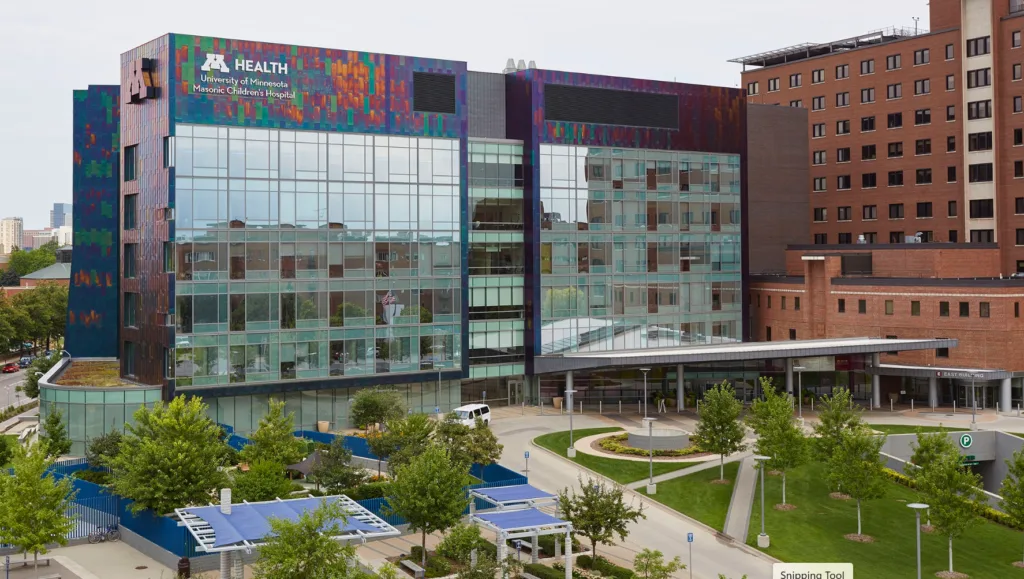
The M Health Fairview University of Minnesota Masonic Children’s Hospital, located on the West Bank of the Mississippi River, is a 200-bed facility. A leader in pediatric care, Masonic Children’s Hospital offers specialized services in neurology and neurosurgery for conditions such as brain tumors, hydrocephalus, congenital malformations, and trauma.
The hospital houses multidisciplinary teams in neuro-oncology, craniofacial surgery, and other specialties, ensuring a collaborative approach to complex cases. With its focus on innovative treatments and family-centered care, the Masonic Children’s Hospital is a vital resource for advancing pediatric neurosurgery in the region.
Centers of Excellence & Strategic Partnerships
- Center for Magnetic Resonance Research (CMRR): The Center for Magnetic Resonance Research stands as one of the world’s premier imaging research facilities, pioneering the development and application of ultrahigh field magnetic resonance technologies. Housing some of the most advanced MR instrumentation globally, including 7T and 10.5T human systems, CMRR leads the field in developing cutting-edge imaging methodologies. The center’s emphasis on ultrahigh magnetic fields, which it pioneered, has revolutionized our ability to study brain function and structure non-invasively. Through its interdisciplinary approach, combining expertise in physics, engineering, and neuroscience, CMRR continues to push the boundaries of what’s possible in neuroimaging research and clinical applications.
- Canine Brain Tumor Program: The Canine Brain Tumor Program represents a unique translational research initiative that bridges veterinary and human medicine. This innovative program provides cutting-edge therapies to dogs with spontaneous brain tumors while simultaneously advancing treatments for human patients. The program has pioneered several breakthrough therapies, including novel immunotherapy approaches and targeted drug delivery systems. Funded by multiple prestigious organizations including the NIH and the American Cancer Society, the program demonstrates the University’s commitment to “One Health” research approaches. Current clinical trials include investigations of targeted therapeutics and personalized vaccine therapies, making it one of the most comprehensive comparative oncology programs in the nation.
- Masonic Institute for the Developing Brain (MIDB): The Masonic Institute for the Developing Brain represents a groundbreaking initiative that unites clinical care and research in pediatric neurodevelopmental conditions. As one of the first facilities of its kind, MIDB serves as a one-stop destination for families seeking comprehensive care for children with neurobehavioral conditions. The institute brings together world-class experts in neuroscience, pediatrics, psychiatry, and psychology to advance understanding of brain development from early childhood through adolescence. Through its integrated approach to research and clinical care, MIDB exemplifies the translation of scientific discovery into practical treatments, while its state-of-the-art facilities provide an ideal environment for collaborative research and patient care.
- Udall Center of Excellence for Parkinson’s Disease Research: The University of Minnesota is home to one of only nine Morris K. Udall Centers of Excellence for Parkinson’s Disease Research designated by the National Institute of Neurological Disorders and Stroke (NINDS). The Center exemplifies the institution’s prominence in functional neurosurgery, particularly in the treatment of movement disorders. Through pioneering work in deep brain stimulation (DBS), the program has established itself as a leader in both clinical care and research innovation. The Center’s multidisciplinary approach integrates advanced neuroimaging, sophisticated neurophysiology, and cutting-edge DBS techniques to improve outcomes for patients with Parkinson’s disease and other movement disorders. This expertise extends beyond movement disorders to include comprehensive functional neurosurgery programs in epilepsy, pain management, and psychiatric disorders. The department’s close collaboration with Medtronic, Abbott, and other industry leaders has facilitated numerous breakthrough developments in neuromodulation technology and surgical techniques. The program’s strengths are further enhanced by state-of-the-art facilities including intraoperative MRI capabilities, ROSA robotic assistance, and advanced neurophysiological monitoring, positioning it as one of the premier functional neurosurgery programs in the nation.
- Comprehensive Stroke Program: The University of Minnesota’s Comprehensive Stroke Program is a distinguished center of excellence within the Department of Neurosurgery, offering full-spectrum, world-class care—from evaluation and treatment to rehabilitation and research. The program operates two Comprehensive Stroke Centers at the University of Minnesota Medical Center and Fairview Southdale Hospital, providing advanced treatment options for ischemic strokes.
- The interdisciplinary stroke program partners experts from neurology, neurosurgery, and radiology to deliver world-class stroke care. This collaborative approach ensures that patients receive timely and effective interventions, contributing to improved outcomes and reduced disability. The program’s commitment to integrating clinical excellence with innovative research solidifies its status as a leader in stroke care and a vital component of the Department of Neurosurgery’s mission to advance neurological health.
- Stem Cell Institute: The Stem Cell Institute, uniquely located on the University of Minnesota campus, is a world-leader in regenerative medicine research, with expertise in neural stem cell applications. The institute’s researchers are pioneering treatments for neurological conditions including spinal cord injury, stroke, and neurodegenerative diseases. Through close collaboration with the Department of Neurosurgery, the institute facilitates the translation of laboratory discoveries into clinical therapies. Their work in neural repair and regeneration has led to several groundbreaking clinical trials, positioning the university at the forefront of regenerative medicine research.
- Biomedical Engineering (BME): The Department of Biomedical Engineering serves as a crucial bridge between engineering innovation and clinical application, with strength in neural engineering and neuromodulation technologies. The department maintains strong partnerships with Minnesota’s medical device industry leaders and the Department of Neurosurgery, facilitating the development of next-generation neurosurgical tools and techniques. Research focuses include neural interfaces, biomaterials for neural repair, and advanced imaging technologies, with numerous successful translations of research into clinical practice.
- Center for Neuroengineering: The Center for Neuroengineering represents a multidisciplinary hub for the development of neural interfaces and therapeutic technologies. The center excels in brain-computer interface development, neural stimulation technologies, and rehabilitation engineering. Through collaborations with the Department of Neurosurgery, the center advances innovative solutions for neurological conditions, particularly in the areas of movement disorders and neural rehabilitation. Their work has led to several breakthrough technologies in deep brain stimulation and neural monitoring.
- Department of Neurology: The Department of Neurology stands as a premier clinical and research partner, offering comprehensive expertise across the spectrum of neurological disorders. The department maintains particularly strong programs in movement disorders, epilepsy, and neurodegenerative diseases, with close integration with neurosurgical services. Their collaborative approach to patient care and research has resulted in numerous innovative treatment protocols and clinical trials, especially in the areas of deep brain stimulation and epilepsy surgery.
- Department of Psychiatry: The Department of Psychiatry provides essential expertise in neuropsychiatric conditions and behavioral neuroscience, maintaining strong collaborative relationships with neurosurgery for conditions requiring surgical intervention. The department’s research portfolio includes significant work in neuromodulation for psychiatric disorders, adding depth to the institution’s capabilities in functional neurosurgery. Their integrated approach to mental health care and research strengthens the comprehensive nature of neurological and psychiatric care at the institution.
- Department of Neuroscience: The Department of Neuroscience serves as a foundational pillar of basic and translational neuroscience research at the University of Minnesota. The department’s research spans molecular to systems neuroscience, with strength in neural circuit analysis, synaptic plasticity, and neurodevelopment. Their work provides crucial basic science insights that inform neurosurgical approaches and treatments. The department maintains strong collaborative relationships with clinical departments, facilitating the translation of basic science discoveries into therapeutic applications.
- MN Drive (Minnesota Discovery, Research and Innovation Economy): MN Drive represents a landmark partnership between the university and state government, focusing on advancing Minnesota’s knowledge economy in key areas including brain conditions and neurotechnology. The initiative provides crucial funding and support for innovative research projects, particularly those with potential for commercial application. Through MN Drive, numerous neurosurgical innovations have moved from concept to clinical application, strengthening Minnesota’s position as a leader in medical device development and neurotechnology.
- MDTA – Optical Imaging: The Minnesota Discovery and Translation Accelerator’s Optical Imaging program pioneers advanced neuroimaging technologies, with particular emphasis on intraoperative imaging solutions. The program develops and implements cutting-edge optical imaging techniques that enhance surgical precision and outcome assessment. Their work in fluorescence-guided surgery and real-time neural imaging has revolutionized approaches to tumor resection and functional neurosurgery.
- MINCEP – Epilepsy: The Minnesota Comprehensive Epilepsy Program (MINCEP) stands as one of the nation’s premier centers for epilepsy care and research. The program combines advanced diagnostic capabilities, including state-of-the-art monitoring facilities, with innovative surgical treatments. Through close collaboration between neurology and neurosurgery, MINCEP provides comprehensive care for complex epilepsy cases, while advancing research in surgical techniques and neuromodulation approaches for seizure control.
- Radiation Oncology – Neuroradiation: The Department of Radiation Oncology’s Neuroradiation program offers cutting-edge treatment options for brain and spine tumors, utilizing advanced technologies including stereotactic radiosurgery and proton therapy. The program maintains close collaboration with neurosurgery for multimodal treatment approaches, particularly in complex brain tumor cases. Their expertise in precision radiation delivery and treatment planning enhances the comprehensive nature of neuro-oncological care at the institution.
- Grossman Center for Memory Research and Care: The Grossman Center for Memory Research and Care, part of the Alzheimer’s Disease Research Center, leads innovative research into memory disorders and neurodegenerative conditions. The center combines clinical care with cutting-edge research, particularly in early detection and intervention strategies. Their work in understanding neural circuits involved in memory provides crucial insights for neurosurgical approaches to memory disorders and cognitive dysfunction.
- Medical Alley – A Hub for Medical Device and Biotechnology Industry Connections: The University of Minnesota’s strategic location in the heart of Medical Alley provides unparalleled access to leading medical device companies including Medtronic, Abbott, and Boston Scientific. These partnerships facilitate rapid translation of research into clinical applications, particularly in areas such as neuromodulation, surgical navigation, and implantable devices. The strong collaborative relationship between academic neurosurgery and industry partners has led to numerous breakthrough technologies and continues to drive innovation in neurosurgical techniques and technologies.
- TBI Research Program: The Traumatic Brain Injury Research Program, supported by significant state funding and VA collaboration, conducts cutting-edge research into TBI treatment and recovery. The program benefits from a unique combination of resources including three Level 1 Trauma Centers in the Minneapolis-St. Paul area and dedicated research facilities at the VA. Current research focuses on advanced imaging techniques, biomarker development, and novel therapeutic approaches for both acute and chronic TBI, with particular emphasis on military-relevant injuries and sports-related concussion.
- Institute for Translational Neuroscience (ITN): The Institute for Translational Neuroscience (ITN) at the University of Minnesota serves as a hub for collaborative neuroscience research, bringing together experts across multiple disciplines to accelerate the development of new treatments for neurological conditions. The Institute encompasses several centers of excellence, including the Center for Neuroengineering, Center for Neurodegenerative Disease, Center for Neural Circuits, and Center for Clinical Neuroscience. Through these centers, ITN facilitates groundbreaking research in areas such as brain imaging, neuromodulation, neural repair, and precision therapeutics. The Institute’s state-of-the-art facilities and strong partnerships with industry leaders and clinical programs create unique opportunities for translating scientific discoveries into innovative patient care. The Department of Neurosurgery maintains active collaborations with ITN researchers, particularly in areas of functional neurosurgery, neuro-oncology, and regenerative medicine.
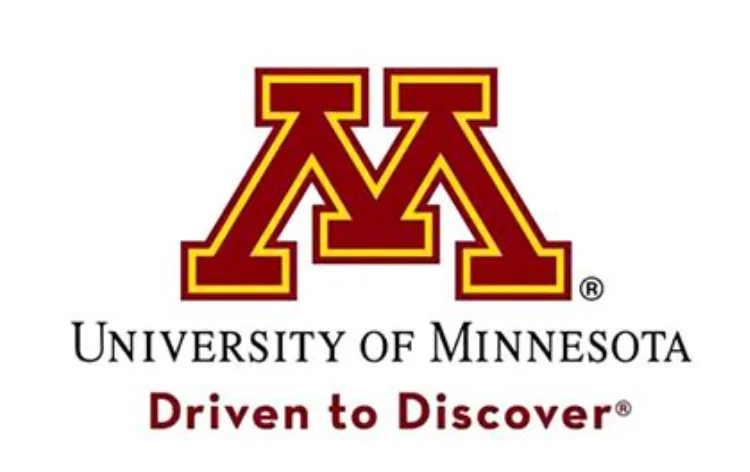
University of Minnesota
The University of Minnesota, founded in 1851, is one of the most comprehensive and prestigious public research universities in the United States. With its flagship Twin Cities campus boasting over 50,000 students, it ranks as the sixth-largest campus student body in the nation. The university offers an impressive array of academic programs, including more than 150 bachelor’s degrees, 200 master’s degrees, and 100 doctoral degrees across 19 colleges and schools.
As a leader in research and innovation, the University of Minnesota Medical School has made significant strides in recent years. In 2023, it ranked number 24 among all medical schools for National Institutes of Health funding, securing over $295M NIH awards. This achievement underscores the institution’s commitment to advancing medical discovery and improving healthcare outcomes. The Medical School’s research prowess is further evidenced by its ranking among the top three public research universities nationally, with more than 30 programs placing in the top 10 nationwide.
The Twin Cities campus offers an exceptional environment for both professional growth and quality of life. Minneapolis-St. Paul is home to 17 Fortune 500 companies, providing ample opportunities for collaboration and innovation. The area has been recognized for its livability, ranking highly in various metrics including literacy, entrepreneurship, and health. With a vibrant cultural scene featuring 130 art galleries, 35 museums, and all four major professional sports leagues, the Twin Cities offer a perfect balance of academic excellence and urban amenities.
University of Minnesota Medical School
Founded in 1888, the University of Minnesota Medical School draws on over 135 years of improving medicine through education, scientific discovery, and giving patients innovative and compassionate care. The University of Minnesota Medical School is a world-class institution committed to innovation, diversity, and excellence in medical education, research, and patient care. The school offers:
- Academic Health: The Medical School is part of one of the premier academic health centers in the country. The University of Minnesota is the only school in the nation to have schools of medicine, dentistry, pharmacy, nursing, public health, and veterinary medicine all on one campus.
- Nationally Recognized Research: Our medical school is revered as a national research powerhouse, with more than 10 research centers and institutes. We have long been recognized for its pioneering and are a worldwide leader in family medicine, regenerative medicine, transplantation, global medicine, and basic science research.
- Our Dean: Jakub Tolar, MD, PhD, is the Dean of the University of Minnesota Medical School and a Distinguished McKnight Professor in the Department of Pediatrics, Blood and Marrow Transplantation. He is also the Vice President of Clinical Affairs at the University of Minnesota, Board Chair for the University of Minnesota Physicians, and co-leader of M Health Fairview
- Research: At the University of Minnesota Medical School, we’re leading the way to new treatments and methods of care. Our research serves as an economic engine that drives Minnesota’s health industry. We develop new health technologies, and we collaborate with Minnesota’s biomedical companies to bring these technologies to clinics and hospitals worldwide. We are finding better and faster ways to translate our laboratory research into clinical trials for patients—the only path to new treatments and cures.
- UMP University of Minnesota Physicians: For more than two decades, the University of Minnesota Physicians (M Physicians) has served as the multi-specialty group practice for the University of Minnesota Medical School faculty. The organization supports the land grant mission of the University by delivering high-quality, innovative, and leading-edge care to patients across Minnesota and beyond. M Physicians is home to world-leading experts in a wide range of specialties and primary care. The organization is dedicated to the discovery of cures and treatments and offers patients access to the latest evidence-based care. University of Minnesota Physicians owns and operates specialty and family medicine clinics, employs more than 1,200 physicians and 2,400 providers and staff, and contributes a significant portion of operating revenue to support the University of Minnesota Medical School’s research and education priorities.

Twin Cities: Minneapolis and St. Paul
The Twin Cities, comprising Minneapolis and St. Paul, offer a vibrant and dynamic environment that is both an economic powerhouse and a cultural hub. With a combined population of nearly 3 million, the metropolitan area is home to 17 Fortune 500 companies, including industry leaders such as 3M, Target, and UnitedHealth Group. This strong economic foundation is complemented by a highly educated workforce and one of the lowest unemployment rates among large metro areas in the country. The region is consistently recognized for its quality of life, with U.S. News & World Report ranking Minnesota as the fifth best state for opportunity, natural environment, infrastructure, economy, and health care.
Beyond its economic strengths, the Twin Cities boast an exceptional cultural scene that attracts creative professionals and families alike. The area is renowned for its diverse arts and music offerings, featuring numerous theaters, museums, and galleries. Outdoor enthusiasts will appreciate the extensive parks and trails system, which includes over 340 miles of interconnected trails and 52 regional parks that welcome more than 47 million visitors annually. The Twin Cities also offer a rich culinary landscape with award-winning restaurants and food trucks, making it a delightful place for food lovers. Whether enjoying professional sports or exploring local festivals, residents find ample opportunities for recreation and community engagement throughout the year.
- The population of the Twin Cities metropolitan area is currently over 3.2 million people
- The Twin Cities offer an exceptional quality of life, combining urban amenities with natural beauty:
- Thriving economic center with 17 Fortune 500 companies
- Consistently ranked among the nation’s most livable cities
- Extensive parks, lakes, and trail systems
- Vibrant arts and culture scene, including world-class museums and theatres
- Excellent public transportation, including light rail connecting downtown areas
- Diverse and welcoming communities
- Four distinct seasons with year-round outdoor activities
Distinguishing Features about the Twin Cities
- Fortune 500 Companies in MSP: Minneapolis proper contains the 5th highest concentration of Fortune 500 companies in the country. The presence of the corporate headquarters for companies such as Target, US Bancorp, Xcel Energy and Ameriprise Financial provide a growing economy with great job opportunities for a candidate’s spouse or family.
- Arts & Culture: Additionally, an exciting arts and music scene, exceptional shopping, award-winning restaurants, wineries and craft breweries, and distinctive accommodations can be found throughout the area. Outdoor enthusiasts find plenty to do – even when temperatures dip, the variety of fun outdoor adventures does not. Sports fans cheer on their favorite team year-round. Big city bustle or small-town charm, anyone can find the activity that suits them in the Minneapolis-Saint Paul Area.
- Heart of the Midwest: Minneapolis-Saint Paul is a metropolitan area in the heart of the Midwest, and the largest city in the state of Minnesota. It offers a high quality of life, excellent public schools, and a strong economy, consistently ranking as one of the best places to live in the United States. The area boasts a thriving arts and culture scene, with world-class museums, theaters, and music venues, as well as extensive park systems, lakes, and trails for outdoor enthusiasts.
- Hub for Medical Innovation & Research: Minneapolis-Saint Paul is recognized as a hub for medical innovation and research, with numerous healthcare organizations, including the world-renowned University of Minnesota Medical School, located in the region. Despite its many amenities, the area has a relatively low cost of living compared to other major metropolitan areas in the United States.
- Twin Cities – A Rich History: The Twin Cities also have a rich history of diversity and inclusion, and the University of Minnesota is committed to fostering a welcoming and inclusive community. Additionally, Minneapolis-Saint Paul has a well-developed transportation system, including a light rail system, bus network, and extensive bike paths, making it easy to get around without a car. Overall, Minneapolis-Saint Paul offers a unique blend of urban sophistication, natural beauty, and cultural diversity that make it an attractive location for professionals in a variety of fields, including medicine and healthcare.
How to Apply
The University of Minnesota Medical School has retained the services of Academic Med, a national executive search firm that specializes in Academic Medicine, to assist with this strategically important search. The search for this esteemed position is being conducted by Gentry Zacheis, President & CEO of Academic Med & Jim Hagood, Managing Principal & Co-Founder of Academic Med. All inquiries, nominations, and applications will be handled with confidentiality.
Interested candidates should submit their curriculum vitae and a cover letter to:
- Jim Hagood, Managing Principal of Academic Med: jim@academic-med.com
Equal Opportunity Employer
The University of Minnesota is an equal opportunity educator and employer. All qualified applicants will receive consideration for employment without regard to race, color, creed, religion, national origin, sex, age, marital status, disability, public assistance status, veteran status, or sexual orientation.
Compensation & Salary
This role is dually employed by the University of Minnesota and University of Minnesota Physicians. Salary for the Professor role at the University of Minnesota is dependent upon academic effort of the person hired, and begins at $55,000. Clinical salary, aligned with clinical effort, is provided through University of Minnesota Physicians. Total salary of academic effort, clinical effort and department head role is competitive with market and based on AAMC salary benchmarks. Total salary will be between $833,333 – $1,000,000. There is the potential for an annual bonus of up to 20%.
Application Deadline
The Search Committee, chaired by Dr. Sophia Vinogradov, will be accepting applications, nominations, and inquiries until 5:00 PM Eastern Time on April 18, 2025. All materials must be received by this deadline for full consideration.





